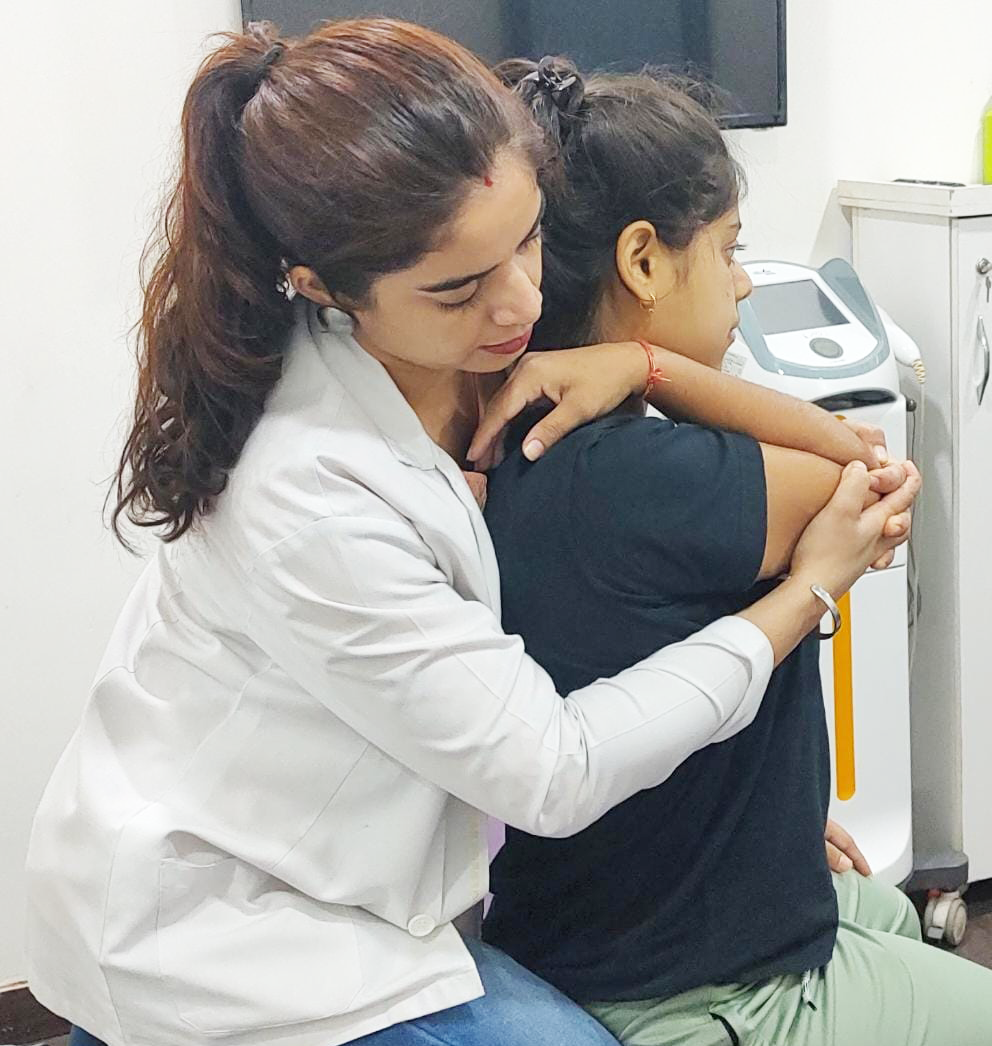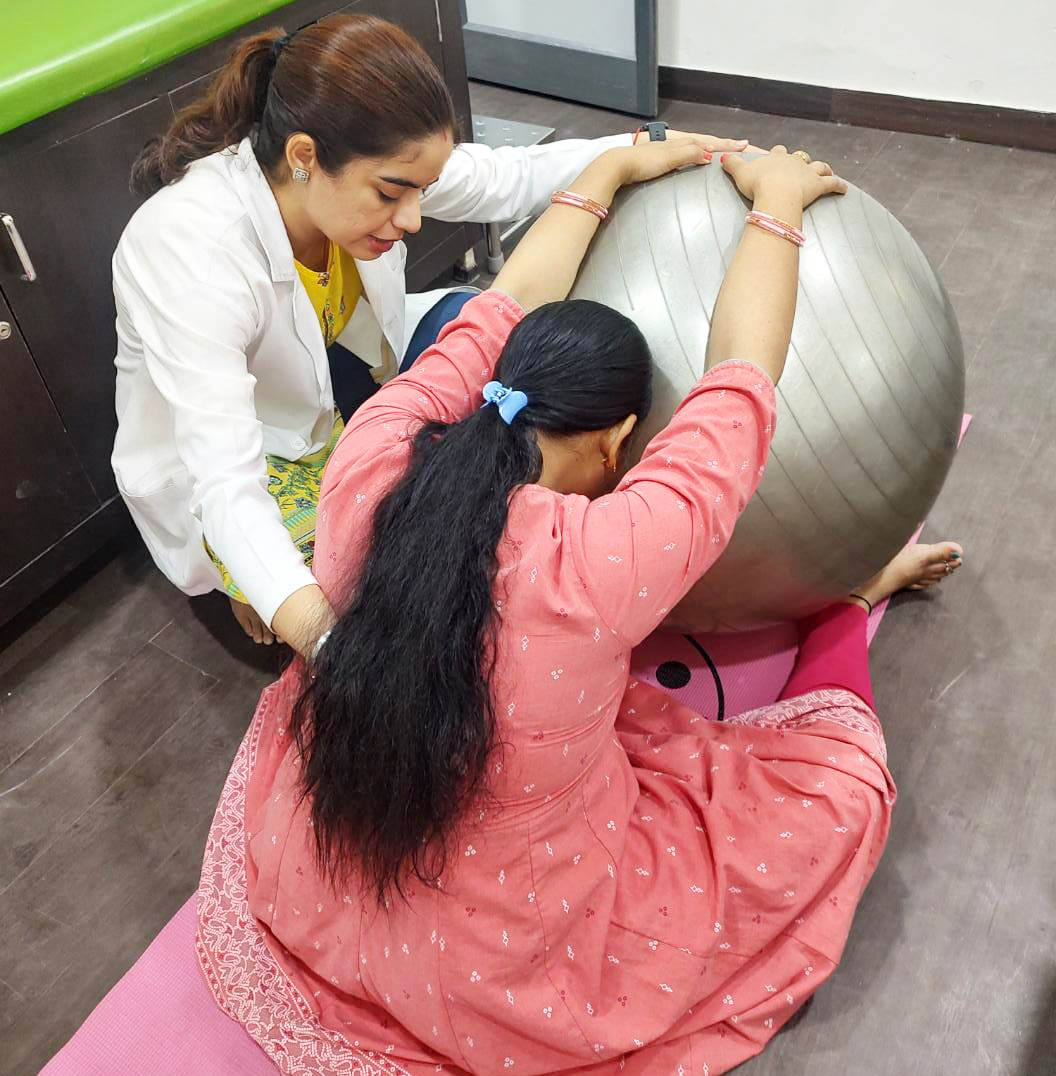We understand that when it comes to your health and well-being, you deserve the best possible care. That's why our team of highly skilled physiotherapists is dedicated to providing advanced and comprehensive physiotherapy services in Chhatarpur, Delhi.
At our advanced physiotherapy, Osteopathy, Chiropractic clinic in Chhatarpur, Delhi, we strive to create a warm and welcoming environment where you can feel comfortable and confident in your treatment. Our clinic is equipped with modern amenities and cutting-edge equipment to facilitate your rehabilitation and recovery process.
Our dedicated team of physiotherapists is highly experienced and trained in a variety of specialized areas, including orthopedic rehabilitation, sports injury management, neurological rehabilitation, geriatric care, and more. We prioritize continuing education and stay up-to-date with the latest advancements in physiotherapy to provide you with the best possible care.
Physiotherapy is a healthcare profession that utilizes various techniques and modalities to restore, maintain, and improve physical function and well-being. It involves the assessment, diagnosis, and treatment of musculoskeletal, neurological, and cardiovascular conditions to optimize movement, alleviate pain, and enhance overall quality of life.

Advanced physiotherapy refers to the application of innovative techniques, modalities, and approaches in the field of physiotherapy to provide high-quality care and enhanced treatment outcomes. It goes beyond traditional methods and incorporates cutting-edge technologies, specialized manual therapy techniques, advanced exercise protocols, and evidence-based interventions. Advanced physiotherapy aims to optimize patient recovery, improve physical function, and alleviate pain through a multidimensional and personalized approach. It may include advanced assessment techniques, specialized equipment, advanced manual therapy techniques, therapeutic modalities like shockwave therapy or laser therapy, and the integration of technology such as virtual reality or biofeedback. Advanced physiotherapy plays a crucial role in addressing complex conditions and promoting optimal patient outcomes.
In addition to our comprehensive services, we utilize advanced treatment techniques to enhance your rehabilitation experience. Some of these techniques include:

We believe in a holistic approach to physiotherapy. We consider each patient as an individual and tailor our treatment plans to meet their specific needs and goals. Our physiotherapists perform thorough assessments to identify the root cause of your condition and design personalized treatment protocols accordingly.
We combine various evidence-based techniques, including manual therapy, therapeutic exercises, electrotherapy, acupuncture, and more, to optimize your recovery. We emphasize active participation and education, empowering you with the knowledge and tools to take control of your health and prevent future injuries.
"PhysioAdviserIndia home care services provide professional physical therapy services delivered in the comfort and convenience of your own home."
We provide "Tele Rehab services” that offer remote access to rehabilitation programs, including virtual consultations, exercises, and monitoring, enabling individuals to receive therapy and guidance from the comfort of their homes."

At our clinic, you will meet best Multispecialty Physiotherapy, Osteopathy, Chiropractic in Chhatarpur, Delhi we understand that every patient is unique, and a "one-size-fits-all" approach does not work in physiotherapy. That's why we develop personalized care plans tailored to your specific needs, goals, and lifestyle.
During your initial assessment, our advanced physiotherapy therapist. Dr. Shardeshu Srivastava and Dr. Shivani Sharma are the best Physiotherapist in Chhatarpur, Delhi and nearby areas, will conduct a detailed evaluation, taking into account your medical history, physical condition, and functional limitations. Based on this assessment, they will create a customized treatment plan, outlining the recommended techniques, frequency of sessions, and expected outcomes.
We value open communication and encourage your active participation in your care. We will regularly assess your progress, modify the treatment plan as needed, and provide you with ongoing support and guidance.


To embark on your journey toward improved physical health and well-being, simply follow these steps:
PhysioAdviserIndia Chhatarpur, Delhi can help you in the following ways:
If you're recovering from surgery, a musculoskeletal injury, or dealing with a chronic orthopedic condition, our orthopedic rehabilitation services are tailored to meet your specific needs. Our team of skilled physiotherapists will assess your condition, develop a customized treatment plan, and guide you through exercises and techniques to improve strength, flexibility, and joint mobility. With a focus on functional recovery, we aim to restore your independence and enhance your quality of life.
Sports enthusiasts and athletes can benefit from our specialized sports injury management services. Whether you're dealing with sprains, strains, ligament tears, or other sports-related injuries, our physiotherapists have the knowledge and expertise to provide effective rehabilitation. We employ a multidimensional approach, combining manual therapy, targeted exercises, and sports-specific training to help you recover, prevent future injuries, and optimize your athletic performance.
Our neuro physiotherapists services are designed to help individuals with neurological conditions stroke, traumatic brain injury, spinal cord injury, Ataxia, and multiple sclerosis, regain their physical abilities and improve their overall quality of life. Whether you're recovering from a stroke, managing multiple sclerosis, or living with Parkinson's disease, our experienced physiotherapists will develop a comprehensive treatment plan to address your specific needs. Through specialized techniques, therapeutic exercises, and neuroplasticity-focused interventions, we aim to promote neurorecovery and enhance functional independence.
In neurological rehabilitation, biofeedback therapy can help individuals develop greater awareness and control over their physiological responses, promoting self-regulation and symptom management. It is often used in conjunction with other rehabilitation techniques to optimize outcomes and improve overall well-being. The specific application of biofeedback therapy will depend on the individual's condition and goals, and it is typically administered by trained healthcare professionals or therapists specializing in neurological rehabilitation.
Geriatric Cardiac Training Program: This program is designed specifically for older adults with cardiac conditions. It involves exercise training and rehabilitation to improve cardiovascular health, endurance, and overall physical fitness in the geriatric population.
Pediatric Chest Physiotherapy: This therapy is targeted at children with respiratory conditions or chest-related issues. It includes techniques such as airway clearance, breathing exercises, and chest mobilization to improve lung function, manage secretions, and enhance respiratory health in pediatric patients.
Chest Physiotherapy and Specific Breathing Exercises: This therapy focuses on individuals with respiratory disorders, such as chronic obstructive pulmonary disease (COPD), asthma, or other lung conditions. It involves a combination of manual techniques, breathing exercises, and respiratory muscle training to improve lung function, alleviate breathing difficulties, and enhance respiratory efficiency.
Post CABG, COPD, Asthma, Angiography Rehab: This rehabilitation program is tailored for individuals who have undergone coronary artery bypass graft (CABG) surgery, have COPD (Chronic Obstructive Pulmonary Disease), asthma, or have undergone angiography. It aims to aid in recovery, restore lung function, strengthen respiratory muscles, and improve overall physical conditioning.
Postural Drainage and Chest Physiotherapy: Postural drainage involves positioning the body in specific ways to facilitate the drainage of secretions from the lungs. Combined with chest physiotherapy techniques, such as percussion and vibration, it helps loosen and clear mucus, assisting individuals with respiratory conditions in clearing their airways and improving lung function.
Advance physiotherapy refers to an advanced level of rehabilitation and therapeutic interventions provided by highly trained and specialized physiotherapists. It encompasses a range of techniques and treatments aimed at addressing complex and challenging conditions, injuries, or specific patient populations.
PhysioAdviserIndia women's health rehabilitation program is a specialized program that focuses on addressing the unique musculoskeletal, pelvic, and reproductive health concerns of women. It aims to promote optimal function, alleviate pain, and improve the quality of life for women dealing with various conditions. Here are some key aspects commonly included in women's health rehabilitation programs:
These programs are typically provided by physiotherapists or healthcare professionals with specialized training in women's health rehabilitation. The goal is to empower women to actively participate in their own recovery, optimize their physical well-being, and improve their overall quality of life.
An antenatal-postnatal program, also known as prenatal-postnatal or pregnancy-postpartum program, is a specialized program designed to support women during their pregnancy and postpartum periods. It focuses on promoting the health and well-being of both the mother and baby throughout these stages. Here are some key aspects commonly included in antenatal-postnatal programs:
These programs are typically led by healthcare professionals, including physiotherapists, midwives, or specialized prenatal and postnatal instructors. They aim to empower women with knowledge, support, and appropriate interventions to optimize their health, promote a positive pregnancy experience, and aid in a smooth postpartum recovery.
It is also known as high-power laser therapy or high-intensity laser therapy, is a form of therapeutic treatment that utilizes a Class 4 laser device. The Class 4 designation refers to the power output of the laser, indicating that it delivers a higher intensity of laser energy compared to lower class lasers. Here are some key points about Class 4 laser therapy:
It's important to note that Class 4 laser therapy should be administered by trained professionals who have an understanding of laser safety protocols and appropriate treatment parameters. If you are considering Class 4 laser therapy, it is recommended to consult with a healthcare provider or therapist experienced in laser therapy to determine its suitability for your specific condition.
Osteopathy is a holistic healthcare approach that focuses on the body's structure and function. Osteopaths use manual techniques to address musculoskeletal issues, restore balance, and promote self-healing. It is beneficial for conditions such as back pain, joint problems, sports injuries, and postural imbalances.
Dry needling is a therapeutic technique used by physiotherapists, chiropractors, and other healthcare professionals to treat muscular pain and dysfunction. It involves the insertion of fine, sterile needles into specific trigger points or tight bands of muscles. The aim is to elicit a therapeutic response, such as the release of tension, improved blood flow, and the reduction of pain and muscle spasms. Dry needling is often used as part of a comprehensive treatment plan alongside other physiotherapy techniques to address musculoskeletal conditions such as myofascial pain syndrome, chronic muscle tightness, and trigger point-related pain.
Cupping therapy is a traditional practice that involves placing suction cups on the skin to create a vacuum effect. It is believed to promote blood flow, relieve muscle tension, and aid in pain management.
Chiropractic is a healthcare profession focused on diagnosing, treating, and preventing musculoskeletal conditions, particularly those related to the spine. Chiropractors use manual adjustments and other techniques to improve joint function, reduce pain, and enhance overall health. They often emphasize the body's natural ability to heal and maintain optimal function.
Therapeutic yoga combines the principles and practices of yoga with therapeutic interventions to address specific health concerns and promote overall well-being. It involves the use of modified yoga poses, breathwork, meditation, and relaxation techniques tailored to individual needs. Therapeutic yoga can be beneficial for various conditions, such as chronic pain, stress-related disorders, anxiety, depression, and musculoskeletal imbalances. It aims to enhance physical strength, flexibility, balance, mental clarity, and emotional resilience, while fostering a sense of relaxation and inner harmony.
Thermotherapy involves the therapeutic application of heat to the body. It promotes healing, reduces pain, and improves circulation. It can be applied through hot packs, heating pads, warm baths, and other heat sources. Thermotherapy helps relax muscles, increase blood flow, and alleviate stiffness, making it beneficial for various musculoskeletal conditions and pain management.
Manual therapy is a hands-on approach used by healthcare professionals to help relieve pain, improve mobility, and enhance overall well-being. It involves skilled techniques applied directly to your body, such as gentle movements, stretches, and pressure. Think of it as a personalized massage that targets specific areas of discomfort or tightness. The goal is to reduce muscle tension, improve joint function, and promote relaxation. Manual therapy can be used for various conditions, such as back pain, neck stiffness, sports injuries, and postural problems. It's like giving your body a helping hand to feel better and move with greater ease.
Let us delve into the many benefits that physiotherapy can bring to your life.
One of the primary benefits of physiotherapy is pain relief. Physiotherapists employ various techniques, including manual therapy, therapeutic exercises, and modalities like heat therapy and electrotherapy, to alleviate pain caused by injuries, musculoskeletal conditions, or chronic pain conditions. Through targeted interventions, physiotherapy can help reduce pain, improve your ability to function, and enhance your overall comfort.
Physiotherapy is instrumental in improving mobility and enhancing overall functionality. Whether you're recovering from surgery, managing a chronic condition, or dealing with a musculoskeletal injury, physiotherapists use techniques like joint mobilization, stretching, and therapeutic exercises to improve range of motion, flexibility, and muscle strength. By restoring optimal movement patterns and functionality, physiotherapy enables you to perform daily activities with greater ease and efficiency.
Physiotherapy plays a crucial role in rehabilitation and recovery following injuries, surgeries, or medical conditions. Through personalized treatment plans, physiotherapists help individuals regain strength, coordination, and function. By guiding patients through targeted exercises, gait training, balance training, and other rehabilitation techniques, physiotherapy supports the recovery process and helps individuals return to their pre-injury or pre-illness level of activity.
Physiotherapy is not only for those recovering from injuries but also for athletes and sports enthusiasts aiming to enhance their performance. Sports physiotherapists have a deep understanding of biomechanics and sports-specific demands. They design specialized training programs, focusing on strength, endurance, flexibility, and injury prevention. Through techniques such as sports massage, therapeutic exercises, and functional training, physiotherapy can help optimize athletic performance and reduce the risk of sports-related injuries.
Another significant benefit of physiotherapy is injury prevention. Physiotherapists assess your movement patterns, muscle imbalances, and potential risk factors to identify areas of concern. They then develop customized exercise programs and provide education on proper body mechanics, ergonomics, and injury prevention strategies. By addressing weaknesses and imbalances, improving posture and technique, and providing guidance on injury prevention, physiotherapy helps you minimize the risk of future injuries.
Physiotherapy is highly beneficial for managing chronic conditions such as arthritis, fibromyalgia, and chronic pain syndromes. Physiotherapists work collaboratively with you to develop personalized treatment plans that address your specific symptoms and limitations. Through a combination of exercises, pain management techniques, joint protection strategies, and lifestyle modifications, physiotherapy can help reduce pain, improve function, and enhance your overall quality of life.
Poor posture and improper ergonomics can lead to musculoskeletal issues, discomfort, and reduced productivity. Physiotherapy can help correct postural imbalances and provide guidance on ergonomic modifications to your work or home environment. By improving posture, spinal alignment, and ergonomics, physiotherapy can alleviate pain, prevent musculoskeletal injuries, and enhance overall musculoskeletal health.
Physiotherapy not only focuses on physical well-being but also contributes to mental and emotional well-being. Through exercise, movement, and hands-on therapy, physiotherapy promotes the release of endorphins, which are natural mood-boosting chemicals. Additionally, the guidance and support provided by physiotherapists can empower individuals, boost their confidence, and improve their overall outlook on life.
You can contact with the best Chiropractic, osteopathy, Physiotherapy services in Chhatarpur, Delhi in a simple way. You can search on Google PhysioAdviserIndia and visit on the official website www.physioadviserindia.comthen fill out the given inquiry form or book appointment. Also you can search on YouTube for their services.